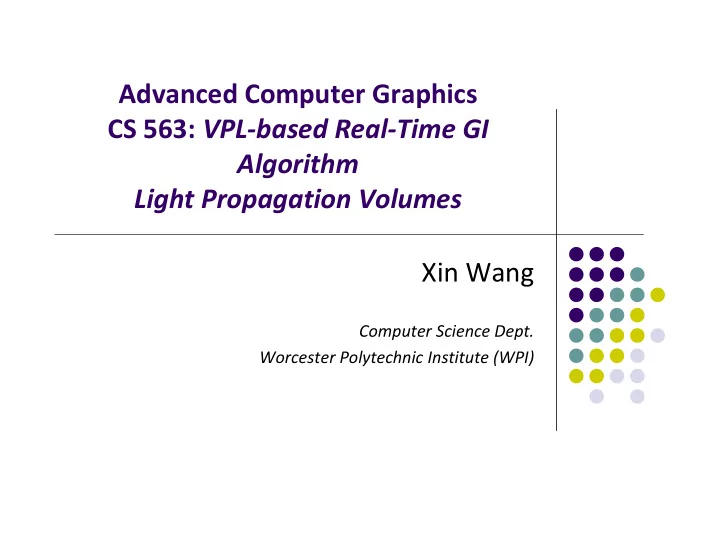

Advanced Computer Graphics CS 563: VPL ‐ based Real ‐ Time GI Algorithm Light Propagation Volumes Xin Wang Computer Science Dept. Worcester Polytechnic Institute (WPI)
Overview
Previous Work Irradiance Volumes [Greger et al. 1997] /SH Irradiance Volumes [Tatarchuk 2004] VPL Visibility [Laine et al. 2007] Lattice ‐ Boltzmann Lighting [Geist et al. 2004] Light Propagation Maps [Fattal 2009]
Massive Lighting Render sliced unwrapped light box into LPV (spatial overdraw vs screen ‐ space, maximum 1024x32 pixels) Convert light’s radiant intensity into SH Shadows are not supported Light in the Light Propagation Volume Coverage in unwrapped render target
Basic Idea
Basic Idea
Basic Idea
Propagation Example
Light Propagation Volume Outline Use many ‐ lights approach to capture sources of indirect lighting Sample directly lit surfaces and initialize 3D grid Represent directional distribution with Spherical Harmonics Inspired by SH Irradiance Volumes [Tatarchuk04] Iterative, local propagation : cell ‐ to ‐ cell
Secondary Light Sources Sample lit surface elements Sample lit surface elements Grid initialization Grid initialization Light propagation in the grid Light propagation in the grid Scene illumination with the grid Scene illumination with the grid
Reflective Shadow Maps Reflective Shadow Map – efficient VPL generator Shadow map with MRT layout: depth, color and normal Depth Flux Normal
Injection Sample lit surface elements Sample lit surface elements Grid initialization Grid initialization Light propagation in the grid Light propagation in the grid Scene illumination with the grid Scene illumination with the grid
Rendering Pipeline – Injection Reflective shadow maps Radiance volume gathering VPL VPL VPL A set of regularly Discretize initial VPL sampled VPLs of the distribution by the scene from light position regular grid and SH
Light Injection into the Volume Every element of Reflective Shadow Map is a secondary lights Render as a point primitive into 3D grid Represent flux in Spherical Harmonics Accumulate all VPLs into the grid The 3D grid is initialized with initial reflected light in the end
Light Propagation Sample lit surface elements Sample lit surface elements Grid initialization Grid initialization Light propagation in the grid Light propagation in the grid Scene illumination with the grid Scene illumination with the grid
Rendering Pipeline – Propagate Reflective shadow maps Radiance volume gathering Iterative propagation VPL VPL VPL A set of regularly Discretize initial VPL Propagate light sampled VPLs of the distribution by the iteratively going from scene from light position regular grid and SH one cell to another
Iterative Light Propagation Local cell ‐ to ‐ cell propagation across the 3D grid Iterate till the light travels through the entire volume Similar to SH Discrete Ordinate Method (used for participating media illumination) Number of iterations depend on the resolution of the grid
The Propagation Iteration 6 axial directions of propagation Use contour faces as a propagation wave front Integrate source intensity by the solid angle to get incoming flux for the face f
The Propagation Iteration Use more than 6 directions Only 6 direct neighbors Compute light propagation to each face of neighbors’ cells 30 virtual directions SHDOM: 27 neighbor cells = 27 directions good trade ‐ off of 4 directions of 8 directions of memory bandwidth propagation propagation “Ray effect” ‐ light propagates in a set of fictitious directions
Reprojection Acquire the incident flux through the receiving face Create a new point light in the center of receiving cell Oriented towards the face Causing exactly the same flux as the face received Generate clamped cosine lobe in SH basis similar to injection stage Accumulate the resulting SH coefficients into the destination cell for next iteration
Rendering Look ‐ up grid with trilinear interpolation Evaluate the irradiance with cosine lobe of surface’s normal Apply dampening factor Compute directional derivative towards normal Dampen based on derivative deviation from the intensity distribution direction
Results of indirect illumination
Cascaded Light Propagation Volumes Motivation: memory and bandwidth cost is o(N^3) for increase of LPV grid Impossible to support large scenes Idea: use multiple nested grids to refine resolution hierarchically Do not consider small objects for large sparse grids Transfer propagated lighting from nested grid to the parent grid Illuminate scene similarly to cascaded shadow maps Reduces the number of iterations sufficient per cascade
Cascaded Indirect Illumination 1 cascade 3 cascades
Multiple Bounces Idea : use information from occlusion grid to compute multiple indirect reflections Reflect light during each propagation iteration Avoid self ‐ illumination by injecting reflected light at safety ‐ distance
Glossy Reflections • Idea: Compute incident light from reflection direction by marching through LPV grid • Go few steps back in propagation time to reduce light smearing • 4 cells is sufficient for moderately glossy objects • Lookups into multiple cells prevent discontinuities in glossy reflections
Conclusion Full ‐ dynamic: scene, view, lighting changes Real ‐ time: GPU ‐ and consoles ‐ friendly Production ‐ eligible (simple tweaking) Highly scalable proportionally to quality Stable, flicker ‐ free Supports complex geometry (e.g. foliage)
References Cascaded Light Propagation Volumes for Real ‐ Time Indirect Illumination. Anton Kaplanyan, Carsten Dachsbacher. ACM 2010 Light Propagation Volumes in CryEngine3. Anton Kaplanyan. Siggraph 2009
Recommend
More recommend